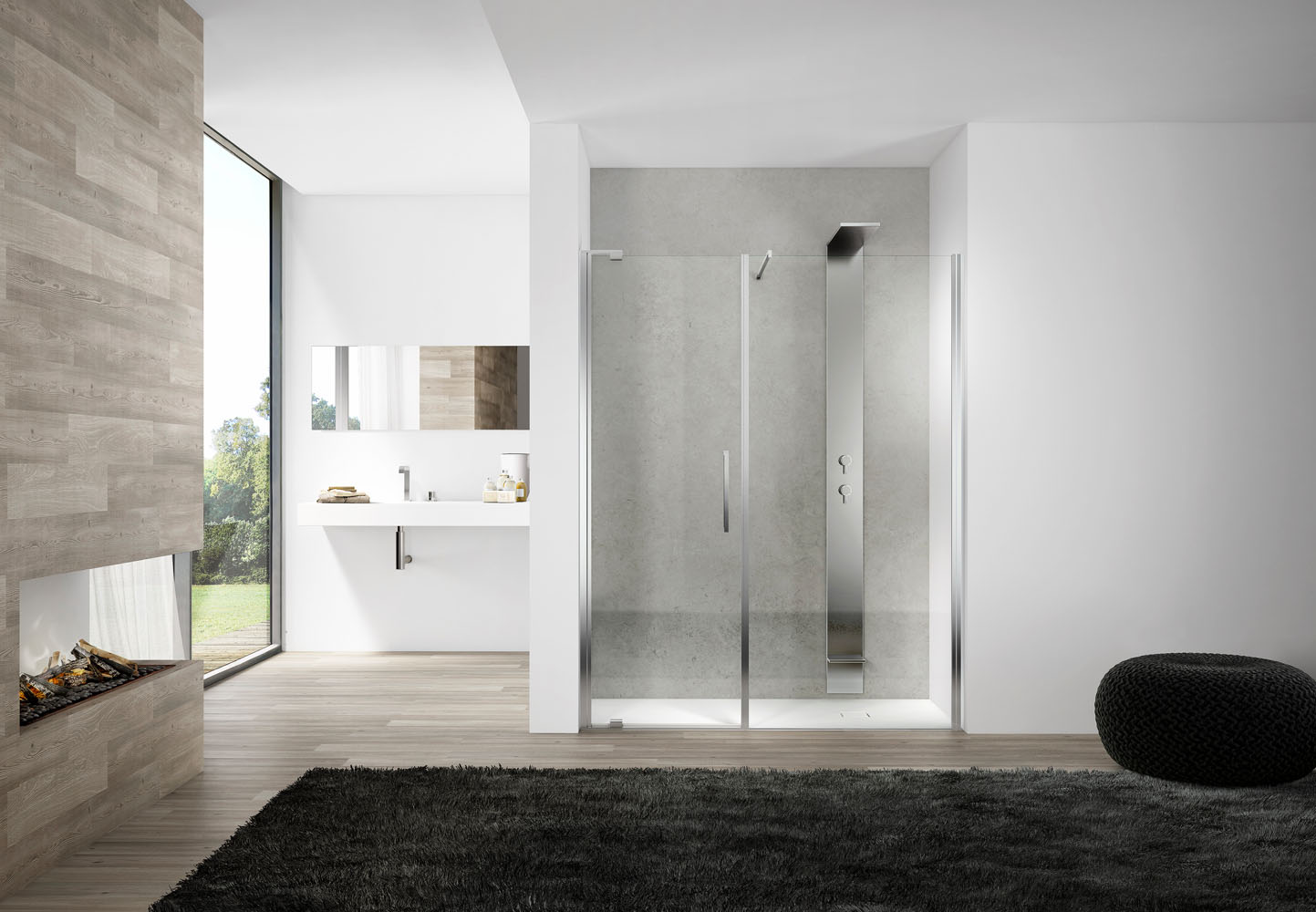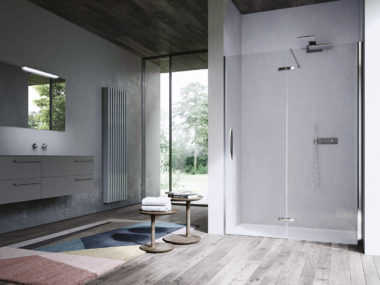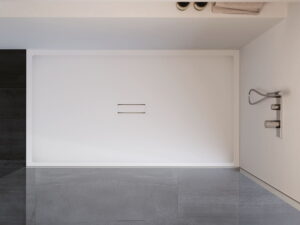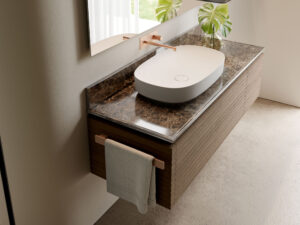Framed vs frameless shower enclosure: this appears to be the first question we face when we start designing our shower. Let’s take a look at the pros and cons of both solutions.
Showers have changed radically over the past few years: the shower enclosure is no longer simply a cubicle – often with a rather flimsy frame mounted on an existing ceramic shower tray with a totally different style – that provides protection against splashing water.
Shower enclosures have also become larger. More precisely, when designing a bathroom we try to keep as much space as possible for the shower, and often opt for one that covers the full width and height of a bathroom wall, mostly windowed. The glass panels have become not only larger but also thicker and therefore sturdier, whereas the profiles have become slimmer (and have totally disappeared in some cases), giving the shower enclosure a minimalist, elegant look.
Originally designed as a necessary item associated to our daily bathroom routine, the shower cubicle has become the central furnishing element of the bathroom, a personal haven of wellbeing available with different glass panel and profile options that can be stylistically coordinated with the bathroom décor.
When is it worth opting for a framed vs a frameless shower enclosure? Is it simply a question of style?
The answer to the last question is no. There are also technical and structural considerations to be made. To understand them, let’s take a look at the pros and cons of both options.
Framed shower enclosure: pros and cons
PRO. The presence of a metal frame adds further flexibility to the shower enclosure, which can be adapted more easily to the size of the shower tray (either raised and flush-mounted): this is particularly important where the shower tray is not perfectly level or where measurements may not have been taken correctly (private customers often provide retailers with broad measurements).
PRO. In the same way, a framed enclosure is more easily adaptable in the case of off-square walls. The alternative option would be cutting the glass panels to size, which not only is difficult and expensive, but also entails a high likelihood or error that will only be discovered during installation.
PRO. Nowadays shower frames are available in a wide range of finishes that match the style and colour of the other bathroom elements, such as taps and fittings, radiators, cabinet handles: for example, bronze/brass finish and black shower frames have become very trendy.
PRO. Framed shower enclosures can be an excellent solution when replacing an existing enclosure installed on a shower tray that is not meant to be replaced. As mentioned above, they can also be adapted more easily in the case of off-square shower trays and/or walls.
CON. With certain models the profiles may make the shower enclosure look a little too bulky, which is something not everyone likes.
CON. The finish chosen for the shower enclosure may be very trendy at the beginning – just think of the popular black finish frames inspired by the industrial style – but may become old-fashioned in the long run.
CON. Framed shower enclosures may be more difficult to clean because of the presence of bulky profiles and seal gaskets. In the case of showers with a sliding door, a practical door engagement and disengagement mechanism makes it possible to clean the shower thoroughly.
PRO / CON. A very volatile factor is the price of framed enclosures: those with an older design may be cheaper (generally cheaper than the all-glass showers) and thus provide a design solution at lower cost; the latest-generation models with the frame either varnished or with a special finish are generally as expensive as the high-end models. In short, framed shower enclosures can be an option based on your spending potential.


Find out more about our FOCUS range of framed shower enclosures »

Find out more about our QUADRO range of framed shower enclosures »
Frameless shower enclosures: pros and cons
PRO. The airy look of a frameless shower enclosure is beyond question. Without a metal frame the shower enclosure – especially if it has clear or preferably extra-clear glass panels – literally disappears, making bathrooms, especially small ones, look much bigger.
PRO. Because there is no frame, the shower has a timeless style that easily matches the style of the bathroom despite passing trends.
PRO. The glass panels can be cut to size , giving you all the creative freedom you need to meet all sorts of design requirements (for example in the case of bathrooms with a low ceiling that are typically found in mountain homes or attics).
CON. A frameless shower enclosure necessarily needs thicker glass panels, which are usually at least 6 mm thick (or, even better, 8 mm thick).
CON. Frameless shower enclosures must be designed very carefully by a professional because even the smallest error could mean that the enclosure cannot be installed. The glass panels must be of exactly the right dimensions, because they cannot be adjusted.
CON. If the walls, floor and/or shower tray are off square, the glass panels must be cut to size (diagonally, if needed), with a higher likelihood of error.
CON. As mentioned above, frameless shower enclosures are more expensive than their framed counterparts (because the price is driven by market demands, and also because thicker glass panels are more expensive in general). Walk-in shower enclosures are a totally different thing. They are more compact and less expensive – for the same size – than shower enclosures with a door.

Discover our PROJECT collection of made-to-measure shower enclosures with hinges »

Find out more about our WALK-IN range of frameless shower enclosures »

Find out more about our SMART range of frameless shower enclosures »
A compromise: ultra-slim hinges and profiles for a truly stylish shower enclosure
Any alternative? Luckily there is an alternative that could accommodate both style and design requirements.
Profiles are becoming slimmer and more minimalist in style, hinges provide opening mechanisms even where there is no profile, support brackets give added sturdiness to the shower enclosure without having an excessive visual impact: modern design shower enclosures seek to combine good looks with exceptional functionality.

Discover our SLIM collection of shower enclosures with pivot hinges »

Find out more about our FREE range of framed shower enclosures with ultra-slim profiles »
In short, before addressing style issues we should try and understand if the best choice is a framed or frameless shower enclosure, carefully considering both subjective and objective criteria.












 Necessari
Necessari
 Funzionali
Funzionali
 Statistiche
Statistiche Marketing
Marketing
2 comments
Wow, I did not know that there were so many different pros and cons for frames or frameless shower enclosures. Although, I can definitely see why one would be better for some homes than the others. I suppose it would just come down to the style and design of you home to find out which one is the best option.
Dear Callum,
thanks for your message.
To know all details of shower enclosures, please visit the dedicated page on our website.
For anything, we’re here.
Comments are closed.